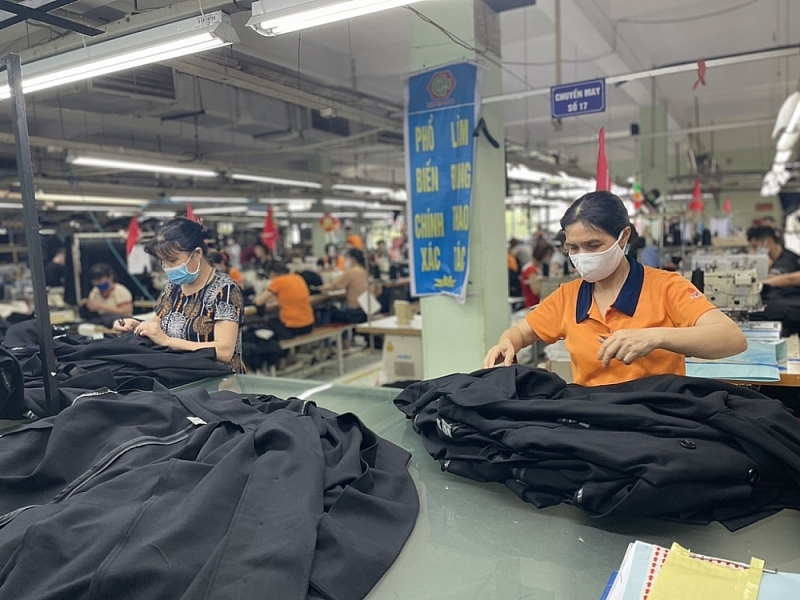 |
| Mr. Truong Van Cam, Vice President and General Secretary of Vietnam Textile and Apparel Association |
How do you evaluate the production and business situation of textile and garment enterprises in the first seven months of 2022?
The production and business situation of textile and garment enterprises in the first seven months of 2022 is quite favorable. Orders were abundant, the workforce gradually stabilized after Vietnam quickly deployed the first vaccine and transitioned to the new normal, flexibly adapting to Covid-19. The whole textile industry has achieved positive results.
Specifically, the total export turnover is estimated at US$26.55 billion, up 16.5% over the same period in 2021.
Total import turnover of textile raw materials and accessories is estimated at US$15.48 billion, up 7.9% over the same period last year. Trade surplus reached US$11.07 billion, up 31% compared to the same period in 2021.
However, from the second half of 2022, businesses face many difficulties and challenges, although the whole industry still keeps the goal of striving for exports of US$43.5 billion.
What difficulties and challenges will Vietnam’s textile and garment industry face in the future, especially in terms of orders and export unit prices?
Textile is a very large import-export industry and is directly affected by unpredictable fluctuations in the world. China, Japan, Taiwan (China) are still applying strict anti-Covid measures, significantly affecting the supply chain of raw materials, auxiliary materials and product consumption.
Besides, economic difficulties, high inflation in major textile consumption markets such as the US and EU made the purchasing power of consumer goods, including textiles, significantly decrease.
This affects orders and unit prices of textile enterprises from now until the end of 2022. Many businesses face a shortage of orders.
In addition, the Russian-Ukrainian conflict is still evolving, with no end in sight, affecting a number of Vietnamese textile and garment markets such as Russia, Ukraine and other countries in the region.
In addition, textile and garment enterprises have to bear costs increased by 20-25% because the price of raw materials, fuel and auxiliary materials has increased rapidly since the beginning of the year.
Specifically, the price of crude oil and gasoline in the country and in the world fluctuated at a high level; transportation costs are 3 times higher than the average of the past 5 years.
Since the beginning of the year, the local currencies of many countries in the region have depreciated significantly against the USD. For example, the Chinese Yuan depreciated 5.3%; Korean Won 4.7%; NT$ 6%; Thai Baht 3.4% and Japanese Yen nearly 16%, while VND only depreciated 1.8%, which is detrimental to exporters.
 |
| The entire textile and garment industry still maintains the export target of US$43.5 billion for the whole of 2022. Photo: Nguyen Thanh |
It must be added that challenges coming from major Vietnamese markets such as the US and EU also create pressure for businesses in the near future such as the issue of tracing the origin of cotton and products made from Xinjiang cotton.
When the “Act against Forced Labor Against Uighurs” comes into effect from June 21, 2022 or intends to charge a carbon fee, the requirement for recycled and reused content for imported goods in the EU market.
What recommendations does the association have for the Government, ministries and branches to help remove difficulties for export businesses and ensure the growth of the industry?
The Vietnam Textile and Apparel Association asked the Government and ministries to provide orientations and recommendations for risks, and to remove obstacles related to payment mechanisms, transportation of goods and documents, etc. countries in the region and around the Russia-Ukraine conflict zone.
In addition, working with countries and provinces that share the same border but have different anti-Covid policies, coordinate to solve problems on the movement of people, vehicles and goods to create favorable conditions for the import and export, meeting the supply of raw materials and auxiliary materials for production, avoiding disruption of the supply chain; oriented to deal with the issue related to the US Uighur Forced Labor Act. Currently, businesses are very confused about this issue.
In addition, the textile and garment industry suggested the Government approve the “Strategy for development of the textile and footwear industry to 2030 with a vision to 2035” to facilitate the formation of large industrial parks with centralized wastewater treatment with advanced technology, green technology, attracting investment in textile dyeing, solving bottlenecks in fabric supply for garment export, meeting origin requirements for tax incentives from Free Trade Agreements.
